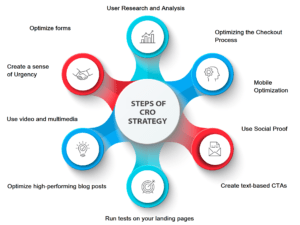How do you increase conversion rate optimization?
Introduction
Conversion rate optimization (CRO) is improving the performance of a website or landing page by increasing the percentage of visitors who take action, for example, making a purchase or filling out a form. This is typically achieved through a combination of design and testing, using tools like A/B testing and heat mapping to understand how users interact with the page and identify areas for improvement. Techniques commonly used in CRO include:
- Improving the usability and user experience of the page.
- Reducing friction in the checkout process.
- Using persuasive design elements like trust badges and customer testimonials.
CRO can help increase website revenue and lead generation and also help to improve the overall performance of a website.
Primary elements of conversion rate optimization
In Conversion rate optimization (CRO), The primary elements of CRO include user research and analysis, testing and experimentation, data analysis, website optimization, ongoing optimization, optimizing the checkout process, mobile optimization, personalization, and trust and credibility elements. Organizations can improve the user experience, increase conversion rates, and drive more revenue by focusing on these elements.
- User research and analysis: This involves understanding the needs and goals of website visitors and identifying any obstacles that prevent them from converting; it is done through user surveys, interviews, heatmaps, and other data collection methods.
- Testing and experimentation: This involves testing different variations of website elements such as headlines, images, copy, and calls to action to see which are most effective at increasing conversion rates. A/B testing and multivariate testing are methods used in CRO.
- Data analysis: This involves analyzing the data collected from user research and testing to identify patterns and insights used to improve the website and increase conversion rates.
- Website optimization: This involves making changes to the website based on the data and insights gathered from user research, testing, and analysis. This can include design, layout, copy, and calls to action changes.
- Ongoing optimization: CRO is an ongoing process, and website optimization should be continuously monitored and updated to stay in line with user behavior and best practices.
- Optimizing the checkout process: The checkout process is critical for most e-commerce sites, and optimizing it can significantly impact conversion rates. This includes simplifying the process, reducing steps, and reducing friction points in e-commerce UI.
- Mobile optimization: With the increasing use of mobile devices to access the web, it’s essential to ensure that the website is optimized for mobile users.
- Personalization: Personalizing the website experience for different visitor segments can help increase engagement and conversion rates.
- Trust and Credibility elements: Building trust and credibility with visitors can be done through various elements such as customer reviews, testimonials, trust badges, and security certificates.
By focusing on these primary elements of CRO, organizations can improve the performance of their website and increase conversion rates.
How to Calculate Conversion Rate?
The conversion rate is the percentage of visitors to a website who take a desired action, such as making a purchase or filling out a form. To calculate the conversion rate, you can use the following formula:
Conversion rate = (Number of conversions / Total number of visitors) x 100
For example, if you had 100 visitors to your website and 10 of them made a purchase, your conversion rate would be 10%.
It’s also common to track conversion rates for specific pages or funnel stages; for example, if you have a landing page and you track the conversion rate of visitors who land on that page and submit a form or make a purchase, this way you can understand the performance of that page and how well it’s converting.
Another example is to track the conversion rate of visitors who land on the homepage, proceed to the checkout page, and then make a purchase. This will give you a sense of how well your homepage is driving visitors to the checkout page and how well the checkout page is converting them into customers.
Conversion rates can also be tracked for specific channels, such as organic search, paid search, email marketing, or social media. This can help identify which channels drive the most conversions and where to focus your marketing efforts.
Where to Implement a CRO Strategy
- Homepage: The homepage is often the first point of contact for visitors to a website, so it’s important to ensure that it’s optimized for conversion. This can include making sure that the most important information is prominently displayed, using clear and compelling headlines, and including calls to action that encourage visitors to take the next step. Additionally, the design should be visually appealing and easy to navigate.
- Pricing Page: The pricing page is an important step in the buying process and is where visitors decide whether to purchase. It’s important to ensure that the pricing information is displayed and easy to understand. It’s also important to include trust and credibility elements, such as customer reviews or testimonials, to build trust with visitors and increase the likelihood of conversion.
- Blog: A blog can be a great way to build trust with visitors and establish your business as a thought leader in your industry. It’s important to ensure that the blog is well-designed and easy to navigate, with clear calls to action encouraging visitors to take the next step. Additionally, the blog has been optimized for search engines to increase visibility and drive more traffic to the website.
- Landing Pages: A landing page is specific webpage visitors are directed to after clicking on an ad or link. It’s important to ensure that the landing page is highly targeted and relevant to the ad or link that the visitor clicked on. The design should be visually appealing and easy to navigate, with clear calls to action encouraging visitors to take the next step. Additionally, tracking the landing page’s conversion rate to understand how well it’s performing is important.
Conversion Rate Optimization Strategies
- User Research and Analysis: Understanding your target audience’s needs, pain points, and behaviors are crucial for an effective CRO. By conducting user research and analysis, you can gain insights into what drives conversions on your website and what obstacles prevent visitors from converting.
- Optimizing the Checkout Process: The checkout process is a critical step in the buying process, and any friction or obstacles in the process can lead to cart abandonment. Optimizing the checkout process can reduce friction, increase trust and credibility, and increase conversion rates.
- Mobile Optimization: With more and more people using their mobile devices to browse the internet, mobile optimization is crucial for effective CRO. By optimizing your website for mobile, you can ensure that it provides a seamless user experience on all devices and increase the likelihood of conversion.
- Use Social Proof: Social proof is a powerful tool that can help increase conversions. By displaying reviews, testimonials, and trust badges, you can build trust and credibility with visitors and increase the likelihood of conversion.
- Create text-based CTAs: Calls to action (CTAs) are essential in conversion rate optimization. By creating text-based CTAs, you can make them stand out more and increase their visibility on the page. This can lead to more clicks and, ultimately, more conversions.
- Run tests on your landing pages: Landing pages are critical to conversion rate optimization. By running tests on your landing pages, such as A/B or multivariate tests, you can optimize elements such as headlines, images, and CTAs to increase conversions.
- Optimize high-performing blog posts: You can optimize them for conversions by identifying which posts are performing well. This can include adding CTAs, lead flows, or other conversion elements to the post to increase conversions.
- Use video and multimedia: Using video and multimedia such as images, infographics, and animations can help to break up text and make the page more engaging. This can increase engagement and, ultimately, lead to conversions.
- Create a sense of Urgency: By creating a sense of urgency, you can encourage visitors to take action. This can be done by using language that implies a limited-time offer, scarcity, or by creating a sense of exclusivity to the offer.
- Use Social Proof: Social proof is a powerful tool that can help increase conversions. By displaying reviews, testimonials, and trust badges, you can build trust and credibility with visitors and increase the likelihood of conversion.
- Optimize forms: Optimizing forms can increase conversions by reducing friction in filling out forms. This can include simplifying the forms, making them mobile-friendly, and reducing the number of fields required to fill them.


